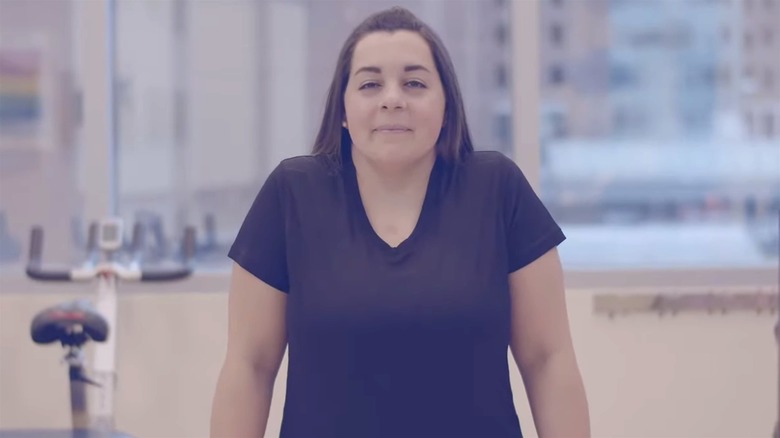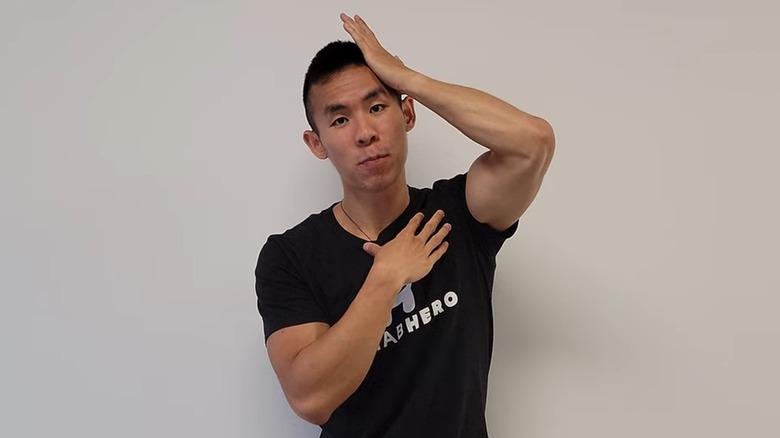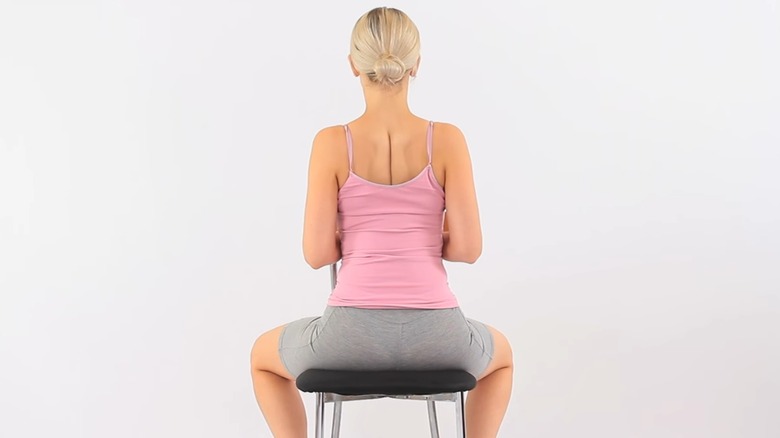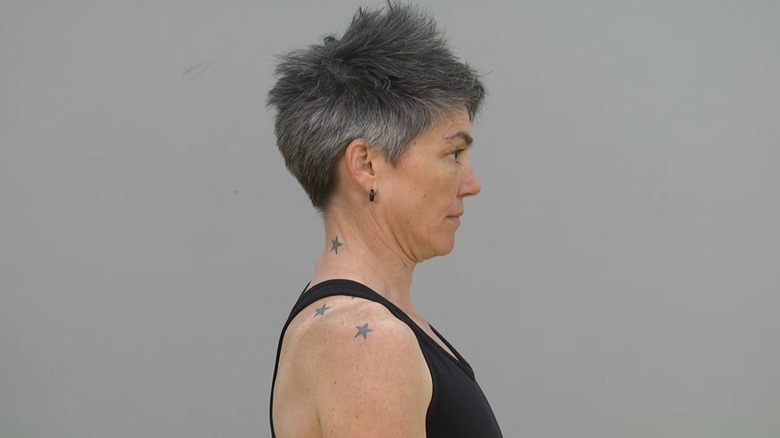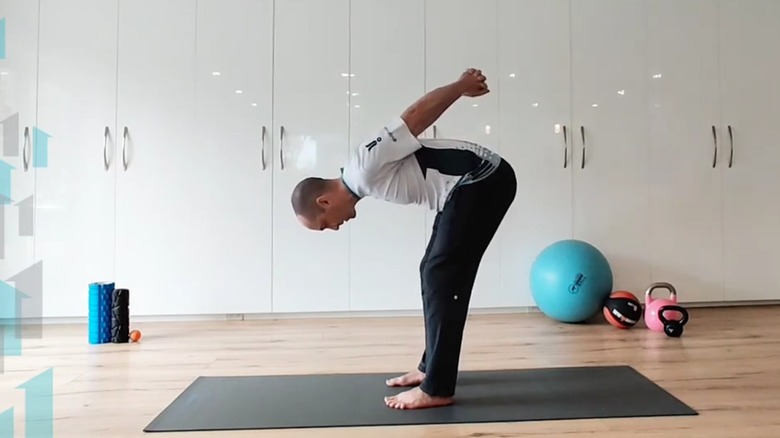Neck And Shoulder Stretches You Can Do Anywhere For Immediate Relief
Modern life often requires sitting in one place for far longer than nature intended on a daily basis. Too much sitting isn't only bad for your overall health — it can lead to muscle fatigue, tightening, pain, and even skeletal weakening of the neck and shoulders over time, according to Yale Medicine. Unfortunately, most of us can't afford to quit our jobs in the name of neck and shoulder health. Instead, you can take the approach of harm reduction by incorporating quick and easy stretches and proper posture into your workday. Side note: there is no universal "good" posture. "Posture is unique to everyone," physical therapist Karen Joubert tells Shape. "It's different from your neighbor's and best friend's."
These neck and shoulder stretches can be done anywhere from your home office to your work desk. You can even do them in the semi-privacy of a public bathroom stall to help release tension and find your spine's natural posture. They don't require any equipment and take just minutes to do. Try completing one or two stretches every 30 minutes to incorporate regular movement throughout your day. This can prevent some of the stiffness that may result from holding the same pose or slouching for an extended period of time.
Simple shoulder shrug
The simplest and easiest way to stretch both your neck and shoulder muscles is the underrated shoulder shrug. All you have to do — as explained by Healthline — is slowly inhale while you pull your shoulders up as close to your ears as possible. When you've reached the highest position that you can comfortably achieve, gently exhale and allow your shoulders to sink back down into their normal position. Focus intently on your inhale and exhale to incorporate an aspect of somatic breathwork into your stretching routine.
Repeat the process of inhaling, shrugging, exhaling, and releasing at least three times, then continue with your day. Anytime your shoulders start to feel tense, sore, or tired from sitting, typing, or any other repetitive task, simply take a moment to complete another set of three shrugs for instant release and relief that can be achieved anywhere. At the end of the day, your neck and shoulders will thank you for the extra attention.
Seated forward fold
In yoga, forward fold is a standing pose that requires the upper half of the body to fold down to meet the lower half. According to Women's Health, an adapted seated version of this move can help you release the tension in your neck (and upper back). To give it a try, scoot to the edge of your chair and lower your chin to your chest. Wrap your arms around the back of your shoulders in a tight embrace.
Hold your arms firmly as you inhale and notice how your breath expands up into your back and neck. After you exhale this breath, engage your abdominal muscles and use them to extend the exhale, emptying the last bit of air from your lungs. Hold the pose and repeat the inhale and extended exhale two or three more times, allowing the expansion of your lungs to gently stretch the muscles of your neck, shoulders, and back each time.
Standing shoulder roll
Shoulders that feel tense, tight, and rigid are a sure sign that you're feeling the effects of prolonged sitting and/or the stress of the workday building up in your body. To combat this common scenario and prevent burnout, MyHealth recommends employing the humble standing shoulder roll. Simply get to your feet and stand up as straight as possible. Relax the muscles of your arms until you feel them hang limply at your sides.
Moving only your shoulder blades, shrug your shoulders up toward your ears and then slowly rotate them back in a circular motion until they return to their normal relaxed position. Repeat this process three or four times, and then repeat the set whenever you start to feel excess tension creeping back into your shoulders. As long as your posture remains straight, this stretch can also be performed seated if standing isn't an option when the need to release shoulder tension strikes.
Neck rotations with resistance
The back of the neck is commonly plagued with tension, thanks to poor posture while sitting for extended periods of time. However, the muscle along the side of the neck can become tense, fatigued, or inflamed by the end of the day as well. Adding resistance to a stretch might sound complicated, but it's actually quite easy and requires no additional equipment. In a seated position, Women's Health recommends straightening your posture and turning your head toward one shoulder.
When you begin to feel tension or discomfort (but before the point of pain), hold the pose as you inhale for five counts and exhale for five more. Then, use the opposite hand to put gentle pressure on your head as if you're attempting to push it back into a front-facing position. Hold your turned position — despite the gentle resistance — for five counts. Repeat the process three to five times, then start over on the other side.
Shoulder blade squeeze
Simply squeezing your shoulder blades together can help stretch the connected muscles as you engage them in a full range of motion. As explained by MyHealth, straighten your posture and fully relax your shoulders — either standing or seated — until they are no longer shrugged or tense. Then, simply pull your shoulder blades back and gently squeeze them together. Inhale for three counts, exhale for three counts, and then release your shoulders back into a relaxed position.
Repeat the process of squeezing, holding, and releasing your shoulder blades 10 times, retaining your straight posture throughout. Any time you start to detect pain or tension in your lower shoulders, upper back, or ribs, complete another set of shoulder blade squeezes to loosen the muscles in the area. Over time, you will condition the muscles to provide more support for the shoulder joints and naturally achieve a healthier posture. This helps prevent muscle fatigue and strain from daily activities like sitting and typing, per Arthritis New South Wales.
Neck retraction
With the amount of time modern humans tend to spend looking at cell phones, laptops, tablets, and television screens, it's no surprise that many necks have become officially out of whack. All this electronic consumption results in a neck posture — known as "tech neck" — that is chronically extended downward and forward, per Honor Health. To combat this phenomenon and the pain associated with it, Hospital for Special Services recommends practicing neck retraction. Start by straightening your spine in either a sitting or standing position.
Face straight ahead and relax the muscles of your neck. Holding your shoulders steadily in place, retract your neck as far backward as you can comfortably go. Hold your retracted neck in place for five seconds, and then release it back into its natural position. Repeat this stretch 10 times to complete one set. Each time you notice your neck becoming tense from stooping down and forward again, perform another set of neck retractions.
Wide-legged standing forward fold
Once you've mastered the seated forward fold, consider moving on to a wide-legged standing forward fold to extend your neck, shoulder, and back muscles even further. As described by Healthline, simply stand with your feet planted wider than your hips and place your hands behind your back, interlocking your fingers. Bend your knees slightly and then bend down at the hips until your head is hanging upside down. Point your interlaced hands up toward the ceiling, tuck your chin to your chest, and hold the pose as you slowly inhale and exhale for 30 seconds.
Since it requires you to stand and engage your leg and core muscles along with your neck, shoulders, and back, wide-legged standing forward fold is an excellent stretch. It can quickly get your blood pumping during a long day of sitting in addition to stretching and conditioning the muscles of your shoulders. All it takes is 30 seconds to take a step towards better health and increased mobility.



